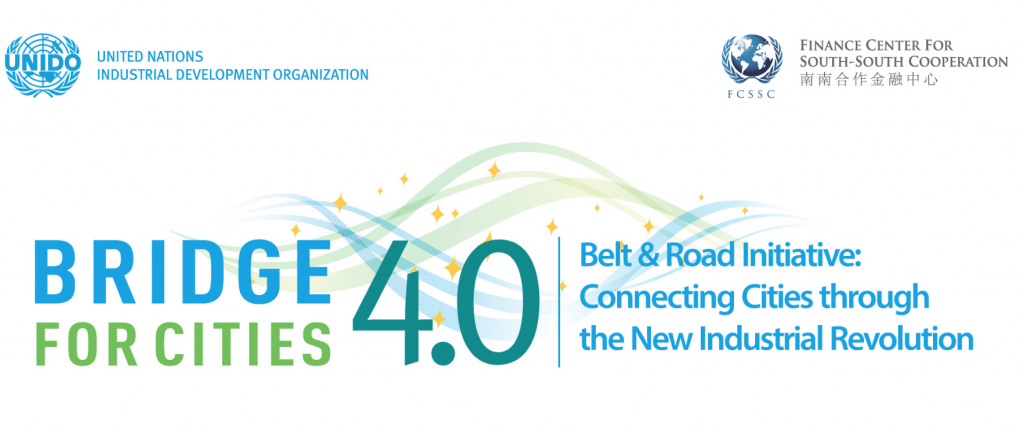On September 3rd 2019, Tomas Diez, Director of Fab Lab Barcelona and of IAAC‘s Master in Design for Emergent Futures, attended the 4th edition of BRIDGE for Cities 4.0, a two-days event co-organised by the United Nations Industrial Development Organization (UNIDO) and the Finance Center for South-South Cooperation (FCSSC) in Viena, Austria. Expert on new technologies and urban innovation in relation to design, architecture and cities, Tomas counted among the few speakers asked here to participate to the “Anchoring Cities in the Circular Economy: The Role of Digital Technology” session. The ambition of this large-scale annual event is to advance the implementation of the 2030 Agenda for Sustainable Development in the context of the Belt and Road Initiative.

Over population, massive urbanisation, energetic and environmental-related-issues, poorer quality of life, etc… Cities have been facing multifaceted challenges. And, considering that by 2050 over two third of the global population should be living in them, they need to find viable alternatives to enhance their smarter and more sustainable transition as from now. But the world keeps changing and their transition must now happen within the context of the New Industrial Revolution, the so-called Industrial Revolution 4.0.
Born from the initiative of the UNIDO and the FCSSC, BRIDGE for Cities 4.0 is a gathering aiming at connecting cities to facilitate the dialogue and exchange of doubts, best practices, successes and so on in order to enhance a common evolution towards a more inclusive and sustainable urban-industrial development.
The aim? Understanding the potential of the Fourth Industrial Revolution to enhance urban innovation and improve people’s living conditions within cities.
How? By exploring how to take advantage of the urban technologies and innovative solutions this new Industrial Revolution has been bringing to improve cities’ quality of life, public services, territorial organisation, job creation while reducing their energetic footprint. BRIDGE for Cities 4.0 intends to evidence that, contrary to a widespread popular belief, urbanisation and cities don’t need to be the environment’s enemies. If considered smartly, urbanisation could help reduce cities environmental impact and carbon footprint if we know how to take advantage of these new technologies to implement a circular economic organisation. This is what Tomas Diez, among others, therefore explained during the session: how to reinvent current production and consumption patterns to anchor a Circular Economy model where data and knowledge could flow globally while materials flow as well but locally. Achieve the transition towards smarter cities would therefore depend on how these technologies and new processes will be understood and applied in future cities.
What is new with this edition? Over the four past editions, BRIDGE for Cities 4.0 have attracted more and more people each year, evidencing the growing consensus there is when dealing with these topics. The novelty of this 4th edition is the creation of a municipal platform connecting cities more easily in order to facilitate the sharing of ideas, challenges but also best practices and successes of case cities. The ambition is that, thanks to this facilitated dialogue, municipal officials and other development stakeholders will want to take their engagement for inclusive and sustainable development in urban areas one step further. The platform should help them forge new alliances and partner up. Moreover, the structure of the event has been revisited in this edition with all sessions and activities focusing on “Industry 4.0”, organised in:
- (Three) Plenary Sessions where the speakers and panellists will provide policy recommendations for urban-development stakeholders, aimed at attaining sustainable urban-industrial development.
- City-to-City matchmaking which was designed to showcase concrete urban and industrial development solutions and partnerships, bringing to the forefront urban stakeholders, mayors and decision makers from selected case cities and regions along the Belt and Road initiative.
- Exhibition and cultural performances: the event will be animated by cultural performances reflecting the cultural heritage and traditions of the countries, regions and cities involved and an exhibition focusing on practical urban solutions and advanced technologies will be on display throughout the event.
As an international academic reference regarding innovation in the field of urbanism, architecture and design, IAAC and its Fab Lab Barcelona, real hub for local, European and international innovation led by Tomas Diez, are both committed to shaping the sustainable continuity of cities.
